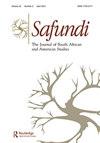Neutrality of a special type: George Loft’s abortive racial reconciliation in the Federation of Rhodesia and Nyasaland, 1957–1960
IF 0.2
Q4 AREA STUDIES
Safundi-The Journal of South African and American Studies
Pub Date : 2021-10-02
DOI:10.1080/17533171.2022.2055869
引用次数: 0
Abstract
Abstract In 1957, George Loft, an American Quaker, arrived in Southern Rhodesia (colonial Zimbabwe) as the field representative of the American Friends Service Committee. In his effort to help the region navigate a period of intense political change in a peaceful manner, Loft cultivated diverse contacts during three years in southern Africa. His attempts to ostensibly serve as a neutral facilitator generally rebounded to the favor of the white settler establishment. While Loft’s often stumbling efforts to steer the region away from violent political conflict were unsuccessful, his shaky balancing act illuminates how quickly an already marginal space for compromise and cooperation across racial divides evaporated. It became virtually impossible to maintain a perception of neutrality. Beyond the evolution and views of the political characters he encountered, Loft’s tenure offers critical context on the demise of the Federation of Rhodesia and Nyasaland and the rise of Zimbabwe’s armed liberation struggle.特殊类型的中立:1957-1960年,乔治·洛夫特在罗得西亚和尼亚萨兰联邦流产的种族和解
1957年,美国贵格会教徒乔治·洛夫特(George Loft)作为美国友会服务委员会(American Friends Service Committee)的实地代表抵达南罗得西亚(殖民地津巴布韦)。为了帮助该地区以和平的方式度过一段激烈的政治变革时期,洛夫特在南部非洲的三年里建立了各种各样的联系。他表面上试图扮演中立调解人的角色,但最终却得到了白人定居者的支持。虽然洛夫特试图引导该地区远离暴力政治冲突的努力屡屡失败,但他摇摇欲坠的平衡行为表明,种族分歧之间本已处于边缘的妥协与合作空间是如何迅速消失的。几乎不可能保持中立的观念。除了他所遇到的政治人物的演变和观点之外,洛夫特的任期为罗得西亚和尼亚萨兰联邦的灭亡以及津巴布韦武装解放斗争的兴起提供了重要的背景。
本文章由计算机程序翻译,如有差异,请以英文原文为准。
求助全文
约1分钟内获得全文
求助全文
来源期刊
CiteScore
1.00
自引率
0.00%
发文量
0

 求助内容:
求助内容: 应助结果提醒方式:
应助结果提醒方式:


